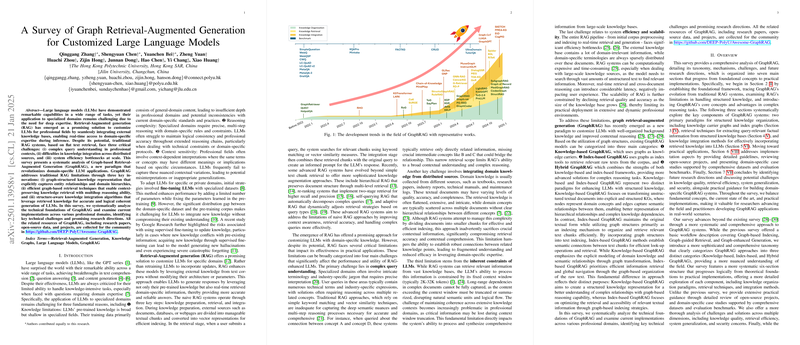The paper "A Survey of Graph Retrieval-Augmented Generation for Customized LLMs" provides an in-depth analysis of GraphRAG, an emerging paradigm that integrates graph-structured knowledge with LLMs to enhance domain-specific applications. Despite the success of LLMs in various applications, they face significant limitations in specialized domains, primarily due to their inability to incorporate extensive and dynamic domain-specific knowledge without retraining. GraphRAG addresses these limitations by organizing external knowledge bases using graph structures, enabling more efficient retrieval and integration compared to traditional RAG methods reliant on flat text retrieval.
Key Innovations and Challenges
GraphRAG is designed to overcome traditional RAG's limitations through several key innovations:
- Graph-Structured Knowledge Representation: Unlike traditional text chunk-based methods, GraphRAG employs a graph structure to rigorously represent entity relationships and domain hierarchies. This allows for more effective query interpretation, especially in complex or professional contexts where relational information is crucial.
- Graph-Based Retrieval Techniques: By employing efficient graph traversal and query planning methods, GraphRAG enhances the retrieval process to maintain the context integrity of domain-specific knowledge. This facilitates multihop reasoning capabilities essential for complex queries.
- Structure-Aware Knowledge Integration: The integration process in GraphRAG leverages the retrieved graph knowledge to generate outputs from LLMs that are not only more accurate but also logically coherent. The intuitive representation of knowledge in graph form provides a structured backbone for enhancing the generation process.
Despite these innovations, the implementation of GraphRAG faces several challenges such as:
- Complex Query Understanding: Requires effective techniques to decode professional jargon and connect disparate knowledge pieces for comprehensive query responses.
- Distributed Knowledge Integration: Tackles the inherent distribution of domain knowledge across multiple documents and the challenge of synthesizing such information without losing context.
- Efficiency and Scalability: Addresses the computational overhead and latency that can emerge from handling large-scale graph-based systems.
Technical Foundations and Implementations
The paper reviews various implementations of GraphRAG across different professional domains, showcasing the versatility and potential of this approach:
- Knowledge Organization: Two predominant graph-based frameworks are discussed: index graphs that efficiently map raw data for retrieval and knowledge graphs that serve as enriched knowledge carriers for LLMs.
- Knowledge Retrieval: Different retrieval techniques such as similarity-based, logical-based, GNN-based, and LLM-enhanced retrieval strategies are detailed. Each tackles specific query types, addressing various retrieval challenges.
- Open Source Projects and Applications: The survey highlights significant open-source projects extending GraphRAG's framework across applications in healthcare, education, legislation, and scientific research, demonstrating its adaptability to domain-specific needs.
Future Directions and Research Opportunities
The paper identifies future research opportunities that could refine and extend GraphRAG, emphasizing areas such as:
- Knowledge Engineering: Automation of knowledge extraction, validation, and update processes to expand and maintain high-quality knowledge bases.
- Knowledge Conflict Resolution: Development of reconciliation frameworks to align and validate external knowledge with LLM-generated insights.
- Privacy and Security: Implementing advanced privacy-preserving mechanisms to safeguard sensitive data when integrating with external knowledge sources.
This comprehensive survey provides a solid foundation for understanding the current state and future potential of GraphRAG in transforming LLMs for specialized purposes through graph-augmented frameworks, offering a promising path for tackling the limitations of traditional LLM applications in diverse professional fields.
